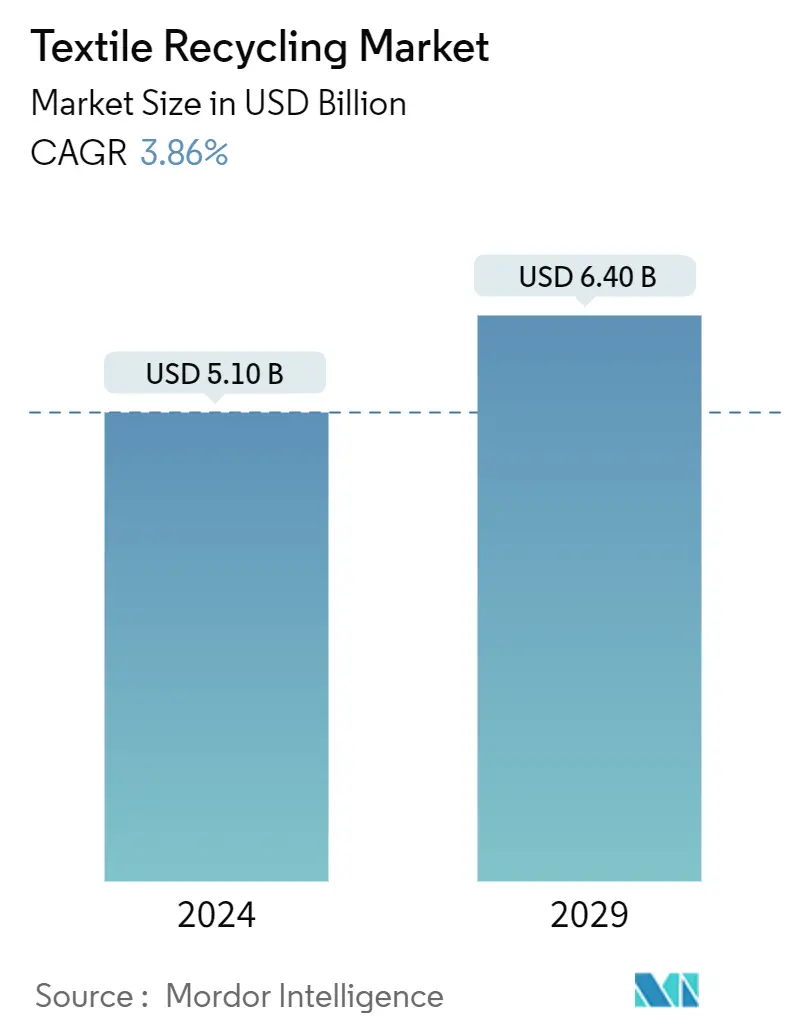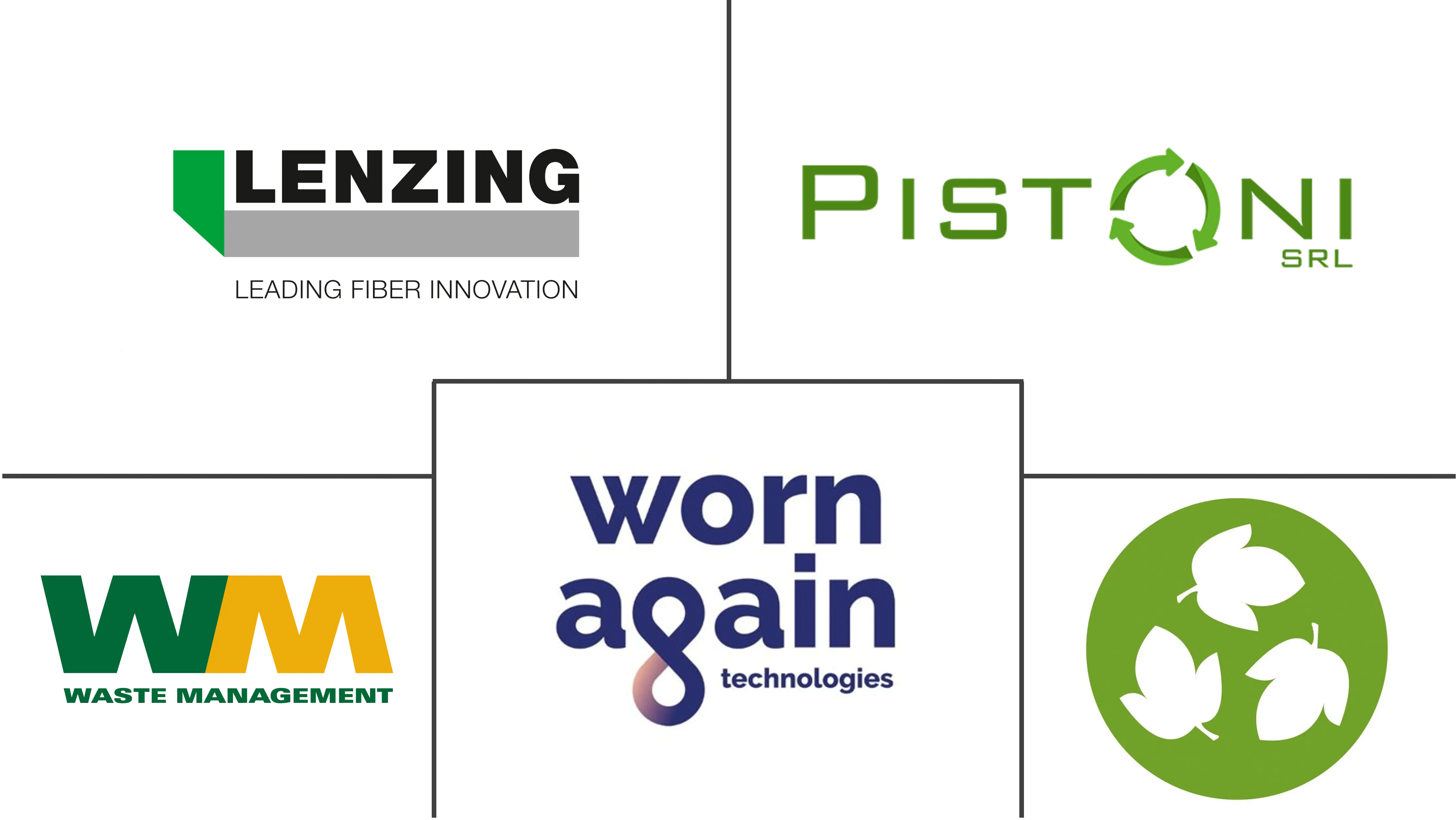Market Size of Textile Recycling Industry

| Study Period | 2020 - 2029 |
| Base Year For Estimation | 2023 |
| Market Size (2024) | USD 5.10 Billion |
| Market Size (2029) | USD 6.40 Billion |
| CAGR (2024 - 2029) | 3.86 % |
| Market Concentration | Medium |
Major Players
*Disclaimer: Major Players sorted in no particular order |
Textile Recycling Market Analysis
The Textile Recycling Market size is estimated at USD 5.10 billion in 2024, and is expected to reach USD 6.40 billion by 2029, growing at a CAGR of 3.86% during the forecast period (2024-2029).
According to industry reports, textiles are the fourth highest source of environmental and climatic change pressure in terms of European consumption. The management of used textiles, as well as textile waste, is a major challenge for Europe. Due to the limited capacity for reuse and recycling in Europe, many used textiles collected within the EU are traded and exported to Africa and Asia, where their future is uncertain.
The US International Trade Commission (USITC) reported in October 2023 that the global apparel sector accounted for 1.8 % of global GHG emissions in 2021. The production of downstream materials (textile fibers and fabrics) accounted for about 90 % of the total sector’s carbon emissions. The industry is expected to significantly exceed its carbon emissions target for 2030, which is set in the 1.5°C pathway by the Paris Agreement.
Government policies are important in driving efforts and innovation in the textile waste management industry. They are a reflection of global and national obligations that drive operationalization and technological innovation in the area of textile waste management. For example, in March 2021, the UK government launched a comprehensive Waste Prevention Program to reduce the environmental and social impact of textile waste, as well as in other sectors focused on key areas such as recycling, regulation, compliance, sustainability, value addition, innovation, and entrepreneurship.
Textile Recycling Industry Segmentation
The textile recycling market includes processes and activities involved in the collection, sorting, processing, and reuse of textile and clothing products to extend the life of textile and clothing products and reduce their environmental impact. In the textile and fashion sectors, it aims to remove textiles from landfills, reduce waste, and promote a circular economy.
A complete background analysis of the textile recycling market, including the assessment of the economy and contribution of sectors in the economy, market overview, market size estimation for key segments, and emerging trends in the market segments, market dynamics, and geographical trends, and the impact of COVID-19 pandemic, is covered in the report.
The textile recycling market is segmented by material (cotton, polyester and polyester fiber, wool, nylon and nylon fiber, and others), source (apparel waste, home furnishing waste, automotive waste, and others), process (mechanical and chemical), and geography (North America, Europe, Asia-Pacific, Middle East and Africa, and South America). The report offers market size and forecasts for all the above segments in value (USD).
| By Material | |
| Cotton | |
| Polyester and Polyester Fiber | |
| Wool | |
| Nylon and Nylon Fiber | |
| Others |
| By Source | |
| Apparel Waste | |
| Home Furnishing Waste | |
| Automotive Waste | |
| Others |
| By Process | |
| Mechanical | |
| Chemical |
| By Geography | ||||||||
| ||||||||
| ||||||||
| ||||||||
| Middle East and Africa | ||||||||
| South America |
Textile Recycling Market Size Summary
The textile recycling market is poised for growth, driven by increasing environmental concerns and regulatory pressures. As textiles rank high among sources of environmental impact, particularly in Europe, managing textile waste has become a significant challenge. The limited capacity for reuse and recycling within Europe has led to the export of used textiles to regions like Africa and Asia, where their future remains uncertain. Government initiatives, such as the UK's Waste Prevention Program and the European Commission's strategies, aim to mitigate the environmental impact of textile waste through regulations and innovation. The European Green Deal further emphasizes the transition to a resource-efficient economy, aligning with global climate goals.
Technological advancements play a crucial role in the evolution of the textile recycling industry. Innovations in recycling technologies, such as those developed by Sulzer Ltd and Worn Again Technologies, are transforming low-value waste into high-value textiles. These technologies are supported by political and economic incentives, including significant investments from the European Union's recovery plans. The competitive landscape features a mix of established companies and new entrants, with global leaders like Worn Again Technologies, Lenzing Group, and Birla Cellulose driving sustainable practices. Collaborations, such as those between Kelheim Fibres and Recycling Atelier Augsburg, highlight the industry's commitment to integrating recycled materials into production processes, further advancing circular economy principles.
Textile Recycling Market Size - Table of Contents
-
1. MARKET INSIGHTS
-
1.1 Current Market Scenario
-
1.2 Technological Trends
-
1.3 Industry Value Chain Analysis
-
1.4 Government Regulations and Initiatives
-
-
2. MARKET SEGMENTATION
-
2.1 By Material
-
2.1.1 Cotton
-
2.1.2 Polyester and Polyester Fiber
-
2.1.3 Wool
-
2.1.4 Nylon and Nylon Fiber
-
2.1.5 Others
-
-
2.2 By Source
-
2.2.1 Apparel Waste
-
2.2.2 Home Furnishing Waste
-
2.2.3 Automotive Waste
-
2.2.4 Others
-
-
2.3 By Process
-
2.3.1 Mechanical
-
2.3.2 Chemical
-
-
2.4 By Geography
-
2.4.1 North America
-
2.4.1.1 United States
-
2.4.1.2 Canada
-
-
2.4.2 Europe
-
2.4.2.1 United Kingdom
-
2.4.2.2 Germany
-
2.4.2.3 France
-
2.4.2.4 Italy
-
2.4.2.5 Russia
-
2.4.2.6 Rest of Europe
-
-
2.4.3 Asia-Pacific
-
2.4.3.1 China
-
2.4.3.2 India
-
2.4.3.3 Indonesia
-
2.4.3.4 Bangladesh
-
2.4.3.5 Rest of Asia-Pacific
-
-
2.4.4 Middle East and Africa
-
2.4.5 South America
-
-
Textile Recycling Market Size FAQs
How big is the Textile Recycling Market?
The Textile Recycling Market size is expected to reach USD 5.10 billion in 2024 and grow at a CAGR of 3.86% to reach USD 6.40 billion by 2029.
What is the current Textile Recycling Market size?
In 2024, the Textile Recycling Market size is expected to reach USD 5.10 billion.

